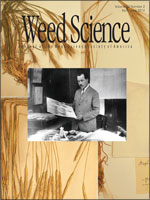First- and second-year seedbank emergence of 23 summer annual weed species common to U.S. corn production systems was studied. Field experiments were conducted between 1996 and 1999 at the Iowa State University Johnson Farm in Story County, Iowa. In the fall of 1996 and again in 1997, 1,000 seeds for most species were planted in plastic crates. Seedling emergence was counted weekly for a 2-yr period following seed burial (starting in early spring). Soil temperature at 2 cm depth was estimated using soil temperature and moisture model software (STM2). The Weibull function was fit to cumulative emergence (%) on cumulative thermal time (TT), hydrothermal time (HTT), and day of year (DOY). To identify optimum base temperature (Tbase) and base matric potential (ψ;base) for calculating TT or HTT, Tbase and ψ;base values ranging from 2 to 17 C and −33 to −1,500 kPa, respectively, were evaluated for each species. The search for the optimal model for each species was based on the Akaike's Information Criterion (AIC), whereas an extra penalty cost was added to HTT models. In general, fewer seedlings emerged during the first year of the first experimental run (approximately 18% across all species) than during the second experimental run (approximately 30%). However, second-year seedbank emergence was similar for both experimental runs (approximately 6%). Environmental effects may be the cause of differences in total seedling emergence among years. Based on the AIC criterion, for 17 species, the best fit of the model occurred using Tbase ranging from 2 to 15 C with four species also responding to ψ;base = −750 kPa. For six species, a simple model using DOY resulted in the best fit. Adding penalty costs to AIC calculation allowed us to compare TT and HTT when both models behaved similarly. Using a constant Tbase, species were plotted and classified as early-, middle-, and late-emerging species, resulting in a practical tool for forecasting time of emergence. The results of this research provide robust information on the prediction of the time of summer annual weed emergence, which can be used to schedule weed and crop management.
How to translate text using browser tools
1 April 2014
Predicting Emergence of 23 Summer Annual Weed Species
Rodrigo Werle,
Lowell D. Sandell,
Douglas D. Buhler,
Robert G. Hartzler,
John L. Lindquist
ACCESS THE FULL ARTICLE

Weed Science
Vol. 62 • No. 2
April-June 2014
Vol. 62 • No. 2
April-June 2014
AIC criterion
information-theoretic model comparison approach
thermal time
weather data
Weibull model




